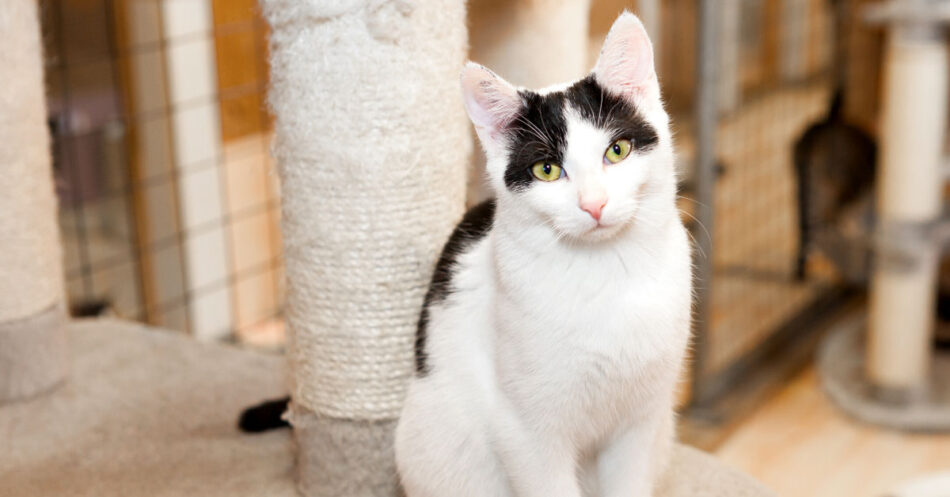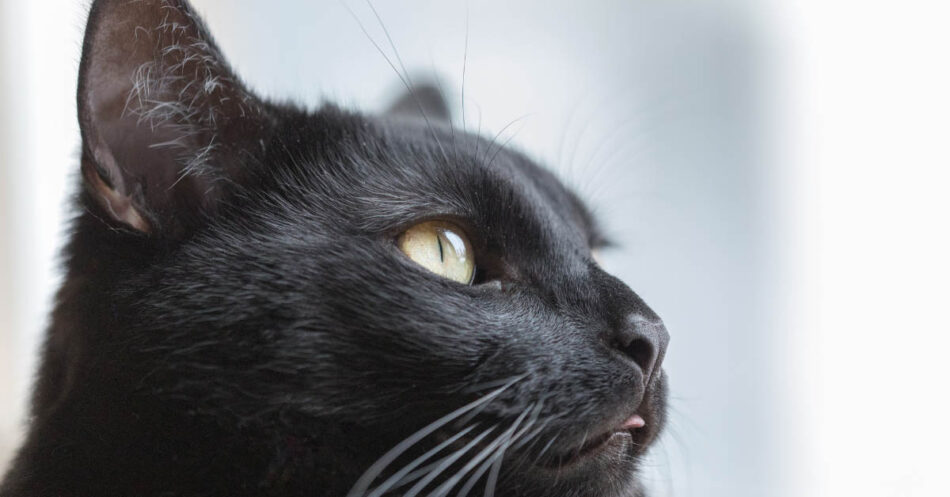
How to Help Your New Cat Adjust to Her New Home
This post may include affiliate links. Please read my disclosure policy.
Fluffy fur, fuzzy tails, and attitude to boot! The thought of bringing home a new kitty makes me swoon. But if you’re reading this, you’ve probably Googled “how to introduce cat to new home” because, in reality, we know introducing a new cat to the home isn’t all cuddles and purrs. It takes a lot of preparation. This is especially true if you’re a first-time cat parent.
Contrary to popular opinion, kitties aren’t as low maintenance as they might seem. Sure, they don’t require daily walks or beg to play a game of fetch. But cats need lots of time, love, regular veterinary care, healthy food, and plenty of toys and supplies.
Plus, cats can live anywhere from 12–18 years (sometimes longer). Introducing a new cat to your home is a serious commitment. But it’s worth every extra step of preparation! The bond you form with your cat will stay with you for a lifetime.

One thing I learned when I brought my cat, Olivia, home is the importance of the first few hours and days after adopting a new cat. Giving your cat a thoughtful start can set the stage for how well and how long it takes her to adjust to her new home.
Pin Me!

Why Your New Cat May Be Anxious
Cats are creatures of habit. Even small changes in a cat’s routine can trigger anxiety. An anxious cat is an unhappy cat. Imagine how your new cat may feel coming into an unfamiliar environment with new people and new smells.
Understanding and recognizing symptoms of anxiety in cats can help you be proactive as you introduce your cat to her new home. Here are a few signs that may indicate your new cat is anxious:
- Dilated pupils
- Trembling
- Twitching tails or ears
- Freezing in place
- Hair standing up
- Hiding
- Hypervigilance
- Increased vocalization
- Increased respiratory rate
You may recognize some symptoms of cat anxiety within the first few days of introducing your cat to her new home. But if these signs persist, it’s best to visit your veterinarian to make sure she’s okay.
How to Introduce Your New Cat to Your Home
Prepare for the Car Ride Home
Before setting the first paw into her new digs, your new cat will need extra love and attention for the car ride home. Unlike dogs, many cats aren’t fans of road trips, even short ones. Your cat might panic, cry, or even get motion sick on the way home. But with advanced preparation, you can make her journey a little easier. Start by getting a high-quality cat carrier.
A cat carrier, like this one from Sleepypod®, is the safest way for a cat to ride in the car. The last thing you want is an anxious cat running free in your car as you’re trying to drive home. She could hurt herself and even cause an accident.
Make the carrier nice and cozy for your cat by filling it with warm, soft blankets for her to snuggle into and feel safe—even better if they’re blankets your new kitty’s familiar with. If you’re concerned she’ll get car sick, lightly cover the cat carrier with a towel.
If you have a long trip home and your new kitty has a history of stressful car rides, try FELIWAY Cat Calming Pheromone Spray.
It’s the #1 veterinarian-recommended solution to help cats adjust to challenging situations, like car rides. Simply spray it in your car or even in your cat’s carrier. Feliway Calming Spray mimics natural pheromones, which helps put your cat at ease naturally and safely.
Buy the Best Supplies For Your New Cat
Kittens and cats may be small, but they need a lot of supplies! So start shopping before you bring a new cat into the home. Stock up on these essential supplies for your cat, and she’ll feel at home in no time:
Food dishes. Choose an option that’s low enough for your tiny friend to eat comfortably. If your heart is set on a raised cat dish, you may want to start with something a little shorter first. Automated pet feeders are another great option. This one from PetSafe allows you to monitor and control your cat’s meals using your smartphone!
Water dishes. A simple water dish will work just fine. But if you really want to treat your cat, try a fountain! My cat Olivia loves hers, and I don’t have to worry nearly as much about whether she’s drinking enough water. And with a fountain, I don’t have to leave the bathroom faucet dripping for her!
A fountain appeals to your cat’s instinct to drink moving water. Many fountains have filters to keep your new cat’s drinking water fresh and clean. I love this one by Catit. Though it might be a little too high for a brand-new kitten, it’s definitely worth bringing out once she’s big enough.
Cat food. Cats are notorious for being picky eaters. If possible, find out what your cat has been eating at the shelter or foster home. Even if you plan on feeding her something different eventually, transitioning her slowly is usually the best choice. I highly recommend asking your veterinarian to recommend the best diet or formula for your kitten or cat. I give Olivia high protein, grain-free cat food from I and love and you. They make dry kibble and canned food too.
Cat treats. Ah, the way to a cat’s heart! Treats aren’t just tasty; they’re also a great way to encourage positive associations with you and even train her a bit, once she’s used to her new home. Like with her food, your cat may turn her nose up at certain treats. Try to get a variety (soft, crunchy, or creamy). Look for options with real meat as the first ingredient. Avoid anything with too much sugar, grain, and artificial stuff. Of course, always be cautious about feeding your cat too many treats as they can be high in calories and pack on extra pounds.
Collars and ID tags. Indoors is paws down the safest place for cats. But even indoor felines should wear a collar and an ID tag at all times. You never know when your cat will discover her inner escape artist.
If your cat gets lost, you want whoever finds her to know right where to bring her! PetHub’s ID tags include a unique QR code that links to your cat’s online profile. Plus, they’re super cute! Most importantly, PetHub gets lost pets home faster than any other organization. About 96% of lost pets with PetHub ID tags are home in under 24 hours. Best of all, less than 2% ever reach an animal shelter.
Thanks to PetHub’s extensive online profile for your pet, their speedy and friendly customer service, and their dedication to reuniting you with your lost pet, you can rest easy knowing your new cat is safe.
Leash and harness. Some cat parents enjoy walking with their cat, if she’ll tolerate it. But even if the only outing your cat ever makes is her regular wellness visit to the vet, you’ll definitely find it easier to get her in and out of her carrier if she’s on a leash! I love these sweet collars and leashes from Blueberry Pet.
Litter box. Choosing a litter box may seem like a no-brainer. But trust me, choosing the right litter box will save you a lot of headaches! Just like humans, cats really care about where they do their business. Olivia and I prefer this simple non-hooded litter box. Check out my blog post to learn the six litter box secrets your cat wishes you knew.
Cat litter. Not all cat litters are created equal. Clay litters are not earth-friendly, and the dust from some litters isn’t healthy for your cat either. Years ago, I dumped my old litter and chose a natural one. Read my blog post here to find out the four things you need to know when choosing a natural cat litter.
Olivia and I paws-itively love World’s Best Cat Litter™. It’s made from naturally absorbent corn, has superior odor control, and clumps like a dream. What’s not to love? Plus it comes in several different formulas, scented and unscented. Olivia and I love their Multiple Cat Lavender Scented formula.
Scratching posts and cat trees. When you’re introducing a new cat to the home, make sure she has a proper place to scratch! You can lessen the chance that kitty will dig her claws into your favorite armchair by giving her a fun scratching post. Make sure your cat’s scratching post stays strong and rigid to withstand all that clawing. I love this one, which combines scratching, climbing, and hiding out into one fun structure.
Lots of toys. Toys are a great way for you to play and bond with your kitty without getting your hands scratched to death. Plus they can keep her entertained when you’re not around. After all, if your new cat is bored, she’ll have a harder time transitioning into her new environment. Bergan Turbo Scratcher Cat Toy combines playtime and scratching into one fun toy! Try buying a bunch of toys and rotating them every few days so the novelty never wears off. Read more about the ten most purr-fect kitten toys here.
Bergan Turbo Scratcher Cat Toy combines playtime and scratching into one fun toy! Try buying a bunch of toys and rotating them every few days so the novelty never wears off. Read more about the ten most purr-fect kitten toys here.
Beds and Caves. Make sure your new cat feels warm and cozy and has a soft bed to lay on after all that playtime. I’m paws over tails in love with these cat bed caves from MEOWFIA or these adorable cardboard cat condos from The Cat in the Box.
How to Cat-Proof Your Home
Cats have a knack for getting into mischief. Although no plan is totally cat-proof, these steps will create a safe environment when bringing a new cat into your home.
- Keep string and cords out of reach. Kitties love to play with anything long and stringy, but they can easily become tangled and choke. It’s best to stash the string and tie your blind cords up out of your cat’s reach. Beware of electrical cords too—some kitties love to chew on them. Put your cords in a cord protector or coat them with something that tastes bad.
- Stowaway cleaning supplies and medications. Childproof containers aren’t necessarily cat-proof! Keep all harmful substances out of reach, preferably in a cabinet equipped with child-proof latches.
- Know your plants. Cats love to nibble on greenery, but some plants are harmful to pets. Put away or throw away anything that could make your cat sick.
- Pay attention to dangerous spots. Cats love to squeeze into small, tight spaces, so recliners, sleeper sofas, and dryers are all potentially dangerous. You probably can’t get rid of these things, but it’s a good idea to know where your cat is before you fold out the recliner or start the dryer.
Put away breakables. Never assume that your cat won’t find a way to that top shelf where you’ve stashed Grandma’s crystal vase. Until you’ve seen your little acrobat’s capacity to climb, it’s best not to leave out anything you don’t want knocked over.
The First Few Days Introducing Your New Cat
Once you’ve prepared and purchased all the essential supplies for your new cat, it’s finally time to bring your kitty home!
Choose a Room to Keep Your New Cat In
It can be a little overwhelming bringing a cat into the home. But you can make the transition easier by restricting her to a single room (like a laundry room or a bathroom) for the first couple of days. If you decide on the bathroom, keep the toilet seat down so your cat doesn’t fall in while she’s exploring. Make sure she’s got a nice secure place to hide out in the cat room while she adjusts.
Isolate other animals and children from your kitty. Once you get her out of her carrier, show her the location of her litter box and her water dish in the cat’s room. Keep all doors and windows closed in the cat’s room, and ensure she has her cat tag on at all times.
Interact with Her on Her Own Terms
Don’t force your cat to socialize. Even though you’ll be dying to hold and cuddle your new kitty, allow her to get to know you on her own terms. The best approach is probably to sit still and let her come to you. Offer her treats if she likes them. Don’t take it personally if she hides. She’ll come around eventually.
Let Her Fully Settle Before Introducing New Areas of Your Home
Too many changes too quickly can be stressful for your cat. Wait until she appears settled and at ease in her room. You’ll know she’s ready to explore more when she’s eating well, using her litter box, and actually wants to hang out with you.
Once that happens, let her check out a new room, but leave the door open to the first room. That way, if she gets spooked, she can run back to her “safe space.” Let her take her own sweet time to explore; there’s no rush.
If she starts acting out—like hissing, hiding, or not eating—she’s probably stressed. It’s perfectly okay to scale back and give her more time to adjust.
Remember, each cat is different. What takes one cat a day or two could take another cat a whole week. The point is to make her feel at home by going at her pace, not yours.
Introduction to Other Animals
Getting pets to get along in one household depends on their personalities—some want to be the boss, and that’s okay. When you bring in a new cat, your resident cat or dog might try to establish dominance right away. It’ll take a bit for things to settle down, and the first couple of weeks will be a busy and stressful time as everyone gets to know each other. Be patient and take it slow and steady.
How to Introduce Your New Cat to Your Resident Cat
Cats can be territorial, so don’t just toss them together and hope for the best. Keep them in separate rooms at first and swap their bedding and their locations so they can get used to each other’s scents. After a few days, let them sniff each other through a cracked door. If they’re not showing any signs of aggression, it’s time for a face-to-face, but keep it short and supervised.
According to Paws.org, spayed or neutered cats are generally more accepting of other cats, and older cats accept kittens quicker than they do with other adult cats.
How to Introduce Your New Cat to Your Resident Dog
Dogs and cats living together works! But introducing your new cat will also depend on your dog’s temperament. First, keep your cat in her own room so your dog can sniff her scent from under the door. Make sure they’re used to each other’s scents by letting them smell each other’s bedding.
When you’re ready for them to meet, put your dog on a leash and let your cat roam free. Pay attention to their body language. If there are no signs of fear or aggression from either side, you can allow closer sniffing. Just be ready to step in if things get hairy. Make sure to give your pup plenty of praise and treats when he is calm around your cat.
How to Introduce Your New Cat to Other Resident Animals
Do you have other pets like birds, hamsters, or rabbits? The intro here is mostly for your new cat’s benefit. Keep your small pets in their cages and let your new cat have a look from a distance. You want your cat to understand that these critters are part of the family. Make sure to always supervise these meetings so everyone stays safe and stress-free.
Once your new cat is comfortable with you and her new home the two of you will be inseparable. The first few days and weeks go by so fast, but if you spend time playing, snuggling, and bonding, you’ll be rewarded with a special feline friend for life!
















When my cat arrived, I first confined her to one room, which contained the food and water dish and a litter box. I also took care to make sure there were toys and blankets which she had enjoyed at her prior home. I frequently went into the room and just sat quietly. Finally, after a week, she ventured out and discovered my bed. She finally let me touch her. Then she discovered that I know how to give a massage to a cat. She loved it, and from that moment, we had developed a bond of trust that let her feel comfortable exploring on her own
Betty,
That is such a sweet memory. Giving them enough time to adjust is key and having things that they are comfortable with in their new space. Thanks for sharing and adopting!
Kristen
I am adopting a new kitten soon, but I am worried about how my adult cat might respond. What is the best way to introduce them?
Caitlyn,
Congrats on your plans to adopt a kitten! There’s a great book by Pamela Johnson-Bennett (cat behaviorist) that you should read called Cat vs. Cat.
Let me know if this helps!
Kristen
Properly buying all of the supplies needed for a new cat first is likely what I have to do before adopting one. This way, when it starts needing things like hygiene care or toys to play with, I’m ready immediately and I can prevent problems from coming up. I’ll have that ready beforehand so I have no issues adopting a cat from a local pet store.
I find it surprising that the right cat litter can make your feline friend feel at home. My friend is planning to adopt a cat after watching a movie that featured these animals and their cuteness. I should talk to him about finding a store that sells these cat litter options someday.